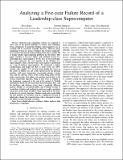| dc.contributor.author | Rojas, Elvis | |
| dc.contributor.author | Meneses, Esteban | |
| dc.contributor.author | Jones, Terry | |
| dc.contributor.author | Maxwell, Don | |
| dc.date.accessioned | 2020-02-12T17:10:31Z | |
| dc.date.available | 2020-02-12T17:10:31Z | |
| dc.date.issued | 2019-10-18 | |
| dc.identifier.uri | http://hdl.handle.net/11056/17204 | |
| dc.description.abstract | Extreme-scale computing systems are required to solve some of the grand challenges in science and technology. From astrophysics to molecular biology, supercomputers are an essential tool to accelerate scientific discovery. However, large
computing systems are prone to failures due to their complexity. It is crucial to develop an understanding of how these systems fail to design reliable supercomputing platforms for the future. This paper examines a five-year failure and workload record of a
leadership-class supercomputer. To the best of our knowledge, five years represents the vast majority of the lifespan of a
supercomputer. This is the first time such analysis is performed on a top 10 modern supercomputer. We performed a failure
categorization and found out that: i) most errors are GPUrelated, with roughly 37% of them being double-bit errors on
the cards; ii) failures are not evenly spread across the physical machine, with room temperature presumably playing a major
role; and iii) software errors of the system bring down several nodes concurrently. Our failure rate analysis unveils that: i) the
system consistently degrades, being at least twice as reliable at the beginning, compared to the end of the period; ii) Weibull
distribution closely fits the mean-time-between-failure data; and iii) hardware and software errors show a markedly different
pattern. Finally, we correlated failure and workload records to reveal that: i) failure and workload records are weakly correlated,
except for certain types of failures when segmented by the hours of the day; ii) several categories of failures make jobs crash within the first minutes of execution; and iii) a significant fraction of failed jobs exhaust the requested time with a disregard of when the failure occurred during execution. | es_ES |
| dc.language.iso | en | es_ES |
| dc.publisher | Institute of Electrical and Electronics Engineers, Incorporated (IEEE) | es_ES |
| dc.rights | Attribution-NonCommercial-NoDerivs 3.0 United States | * |
| dc.rights.uri | http://creativecommons.org/licenses/by-nc-nd/3.0/us/ | * |
| dc.subject | Fault tolerance, resilience, failure analysis, high performance computing. | es_ES |
| dc.title | Analyzing a Five-year Failure Record of a Leadership-class Supercomputer | es_ES |
| dc.type | http://purl.org/coar/resource_type/c_6501 | es_ES |


